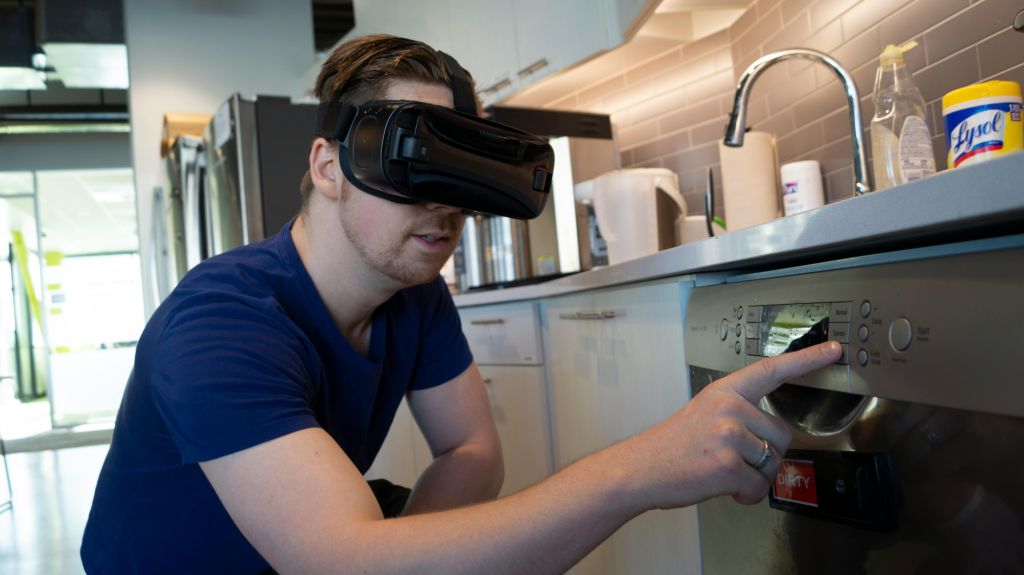
Virtual vs. VR Training: Exploring the Distinctions and Advantages – In education and professional development, one encounters two “virtual” approaches: virtual training and virtual reality (VR) training. While these terms are often used interchangeably, they actually represent two distinct pathways to learning. This blog is an attempt to explain exactly what these two training approaches are, their differences and similarities, and, because building it is our speciality, the unique advantages that only virtual reality training has.
Understanding Virtual Training
Virtual training, at its core, encompasses the realm of learning delivered through simulated environments or across geographical distances. It’s the digital classroom, where learners and instructors converge in cyberspace rather than physical spaces. This method can take various forms, from interactive modules to webinars, catering to a diverse array of learning needs.
In virtual training, learners immerse themselves in simulated scenarios, honing their skills through digital platforms or software. Whether it’s mastering complex software or navigating real-world dilemmas through simulations, virtual training offers a flexible and accessible pathway to skill enhancement.

Understanding Virtual Reality Training
Virtual reality (VR) training is a game-changer in immersive learning. Unlike regular virtual training, VR training immerses users in realistic settings using special headsets. Imagine putting on VR gear and instantly being transported to a surgery room, a cockpit, or a factory floor—where you can interact with everything as if it’s right in front of you.
The magic of VR lies in its ability to transcend the boundaries of conventional learning. It fosters a heightened sense of realism and interactivity, enabling users to practise skills in controlled yet authentic settings. From healthcare to aviation, VR training holds immense potential in industries where hands-on experience in high-risk or intricate environments is paramount.
Similarities and Differences at a Glance
| Characteristic | Virtual Training | Virtual Reality Training |
| Convenience | ✓ | ✓ |
| Geographical Flexibility | ✓ | ✓ |
| Safety | ✓ | ✓ |
| Accessibility | ✓ | ✓ |
| Time Use | ✓ | ✓ |
| Engagement/Lack of Distraction | ✓ | |
| Individual feedback | ✓ | |
| Personalisation | ✓ | |
| Analytics capabilities | ✓ |
Embracing the Unique Powers of VR Training
While virtual training and VR training share common ground in simulating environments, VR training elevates the experience to unparalleled heights. Its immersive nature fosters deeper engagement and experiential learning, offering a dynamic platform for skill mastery. VR experiences have a level of interactivity that virtual training cannot match.
From refining surgical techniques to mastering complex machinery, VR training empowers learners to tackle real-world challenges with confidence. By immersing users in lifelike scenarios, it bridges the gap between theory and practice, revolutionising the way we approach skill development.
As we navigate the virtual realm, it’s essential to grasp the nuances between virtual training and VR training. While both offer valuable learning opportunities, VR training is capable of reproducing real world scenarios and processes almost exactly, incorporating their interactivity and unpredictability. This is one of the reasons why VR training can be regarded as a more powerful tool than virtual training. However, it comes with its own challenges.
While virtual training often is incorporated and built into/onto a company’s existing Learning Management System, true VR applications cannot currently be incorporated into an existing LMS system. Nor can a company’s existing learning materials be quickly and easily “converted” into VR content. This makes sense, given the specialised nature of VR. When embarking on their VR journey, a company will have to decide on what hardware to use. We have written about choosing a headset before so we won’t go into detail about it again here. However, unlikely as it may seem given the number of headsets on the market, it is actually easy to choose the headset that most closely fits a company’s training needs. All they need to do is decide on what priority they give to the power, portability and price of the device they want to use, and the choice of headset will be clear.
On the subject of the training content, in order to fully utilise the power of the VR medium, trainers need to start from a different starting point than 2d media, and that includes video. VR training, where the user can interact with their surroundings, and get real time feedback on their actions, is a much richer experience than anything possible with 2d training materials. Virtual training may seem superficially similar to VR training – for example the trainee may be able to access a 3d environment, either on a desktop/laptop, but conducting virtual training in a 3d environment is simply taking the classroom (and its 2d training materials) into a different setting. There is nothing wrong with this. It is an extended, and arguably more engaging and accessible version of the classroom experience. However, it is not the same thing as true VR, and lacks the interactivity, feedback, personalisation and analytical capabilities that VR training can implement.
In order to implement VR training content, a trainer must collaborate with a VR company (such as Mersus Technologies) and discuss what the training objectives are and how they can be translated into immersive VR experiences. This collaborative effort ensures that the VR content aligns with the specific learning goals and provides the most effective training experience possible.

Furthermore, VR training requires a different approach to instructional design. Trainers must consider factors such as spatial awareness, user interaction, and feedback mechanisms to create engaging and impactful experiences. This often involves the use of gamification elements, branching scenarios, and realistic simulations to enhance learning outcomes.
Despite its challenges, the benefits of VR training are undeniable. It offers a level of immersion and engagement that traditional training methods simply cannot match. By providing learners with realistic environments to practise and refine their skills, VR training accelerates learning and improves retention rates.
So, while virtual training serves as a valuable tool for remote learning and skill development, VR training takes immersive learning to the next level. By embracing the unique capabilities of VR technology, organisations can revolutionise their training programs and empower learners to succeed in an ever-evolving world. As we continue to navigate the virtual realm, let us recognise the transformative potential of VR training and harness its power to shape the future of education and professional development.